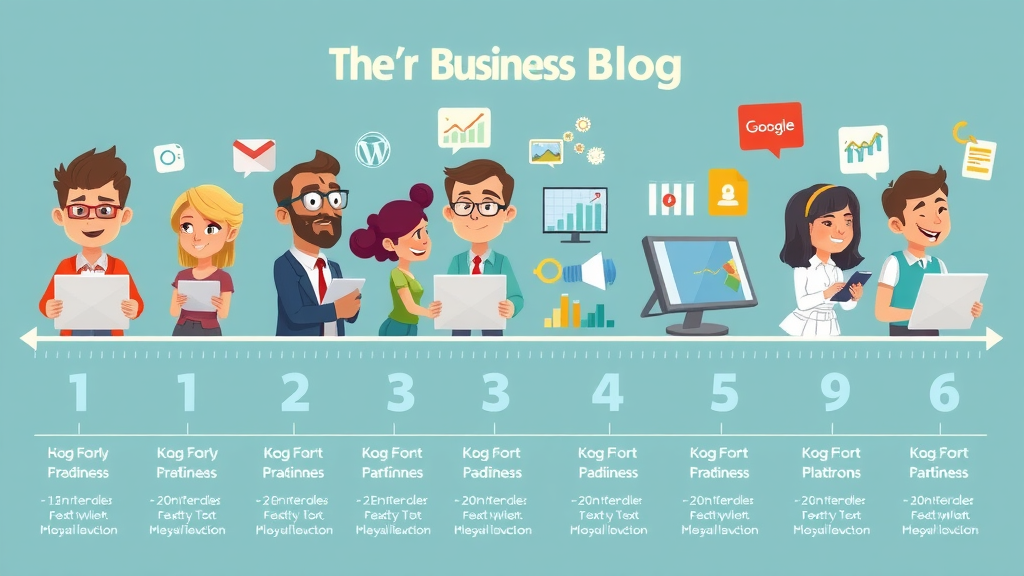Are you risking your competitive edge by ignoring the power of a business blog? In a world where digital noise drowns out even the best brands, your business can’t afford to be silent. The right blog turns site visitors into loyal fans, sparks meaningful conversations, and ensures your brand’s relevance—well beyond flashy ads or fleeting trends.
Now, more than ever, understanding why businesses need blogs could be the game-changer between becoming an industry leader or fading into the background. If you’re ready to discover the transformative benefits of blogging and the actionable steps your business needs, read on.
Have You Considered Why Businesses Need Blogs to Stay Ahead in the Digital Age?
- Discover the essential reasons why businesses need blogs and how leveraging a business blog can transform visibility, credibility, and long-term growth.

- Uncover the practical benefits of blogging that industry leaders and small business owners are capitalizing on right now.
Staying competitive as a business owner requires more than great products or services. Today’s digital marketplace rewards brands that connect and educate . Small business owners and large companies alike are investing in a business blog to increase brand awareness , nurture an email list , and claim higher positions in search engine results . This isn’t just about content marketing—it’s about playing the long game with relationship-building, expertise-sharing, and enhancing your visibility online.
Consider the impact on your target audience: consumers increasingly seek authentic, valuable content before making a purchase decision. Blogs enable companies to answer questions, solve problems, and demonstrate credibility right where it matters—in their own digital space. Ignoring this content channel means missing out on opportunities to attract website visitors, convert leads, and stay top of mind amid the competition. It’s no longer a question of “if” but “how” businesses need blogs to thrive.
Understanding Why Businesses Need Blogs: Unveiling the Core Benefits
Business Blog Fundamentals: What Every Modern Company Should Know
- Definition and evolution of the business blog
- Types of blog posts effective for businesses
At its core, a business blog is a section of your company’s website dedicated to regularly published, relevant articles that cater to your audience’s needs. Originally, business blogs began as informal journals, but today they are sophisticated marketing assets driving search engine optimization (SEO), establishing a brand’s voice, and forming a foundation for content strategy . The evolution from simple posts to robust, multimedia-rich blog content reflects the growing demand for meaningful engagement in the digital space.
Different types of blog posts resonate with various audiences. How-to guides , listicles , industry news , Q&As , and case studies are all effective formats for a business blog . Each format addresses different stages in the buyer’s journey, from building awareness to facilitating the final conversion. Businesses that regularly publish diverse blog post formats find it easier to address customer pain points and establish trust over time.

Maintaining a company blog isn’t just about putting words online; it’s about strategic communication. The best blogs align with your company’s messaging, engage the target audience , and consistently showcase your brand’s personality. Whether you’re starting a business or already established, understanding these fundamentals is a big step toward digital success.
Key Benefits of Blogging for Businesses
- Increasing website traffic organically
- Building brand awareness and authority
- Enhancing content strategy for ongoing engagement
The benefits of blogging for businesses are wide-reaching. A consistent, well-written blog boosts website traffic by capturing new search engine queries each month. Unlike one-time ads, blog posts continue attracting visitors well after publishing—making every post an enduring asset. When you optimize each blog post for relevant keywords, your brand thrives in search engine results, ensuring potential customers discover you first.
Beyond traffic, blogging enhances brand awareness and positions your business as an authority. Thoughtful content builds consumer trust and signals to both audience and algorithms that your business offers genuine value. As a cornerstone for your broader content strategy , blogs help you engage site visitors through educational articles, interactive content, and powerful calls to action that nurture prospects until they’re ready to buy.
| Channel | Impact | Longevity | ROI Over Time |
|---|---|---|---|
| Business Blog | Authority, SEO, engagement, lead generation | Lasting (evergreen posts stay relevant) | Increasing as posts compound |
| Social Media | Brand awareness, real-time engagement | Short-lived (posts buried quickly) | Moderate, requires ongoing effort |
| Email Marketing | Direct communication, nurture leads | Varies (email list decay over time) | Strong with consistent engagement |
| Paid Ads | Immediate reach, targeted exposure | Fleeting (runs only while paid) | Can be costly, stops when spending stops |

Ultimately, building a business blog is about investing in your long-term growth . The value multiplies with every well-crafted post as your content becomes a library that drives consistent results and outperforms relying solely on paid or ephemeral channels.
Why Businesses Need Blogs for Website Growth and SEO
Driving Website Traffic with Strategic Blog Content
- How blog posts help companies rank for relevant keywords
- Integrating blog content with social media and email list building for higher reach
Well-optimized blog content has the power to bring organic website traffic to your site. Each blog post is an opportunity to target specific keywords, answer common customer queries, and land in more search engine results. When your blog consistently solves problems or answers questions for your target audience, search engines boost your ranking—putting you in front of those actively seeking solutions you offer.
Stacking additional layers of strategy, businesses integrate blogs with social media campaigns and email list initiatives. By sharing your post across channels, you broaden your blog’s visibility, attract new website visitors, and keep your email list engaged with relevant, valuable content. More traffic means more leads, which ultimately translates to more sales opportunities.
‘A well-maintained business blog is a 24/7 marketing asset for every small business.’ – Industry Expert
As your blog grows, so does the compounding effect on traffic. Each post can bring in visitors for months—sometimes years—expanding your brand’s reach without continually increasing your marketing spend.
The Role of Blogs in Content Strategy and SEO
- Delivering value and authority to search engines
- Fresh content signals and evergreen blog posts
- Converting readers from blog content into leads and customers
Effective content strategy hinges on producing blog content that resonates with both your target audience and search engines . Each high-quality blog post increases your site’s authority, providing valuable content that search algorithms reward with higher rankings. Search engines crave fresh, relevant information, making regular blog posts essential for maintaining your digital presence.
Evergreen blog posts —those that stay useful and relevant—act as ongoing magnets for new readers, continually attracting site visitors through search engine queries and direct shares. As your perceived authority grows, so does your opportunity to convert blog readers into leads and loyal customers. Strong calls to action, downloadable resources, and links to your products or services turn passive readers into engaged buyers.
With each blog post, your business further cements its reputation online, enabling you to capture search engine result attention, build trust, and generate sales-ready leads without relying solely on paid tactics.
Benefits of Blogging for Business: Insights for Small Business Success
Small Business Spotlight: Why Businesses Need Blogs to Level the Playing Field
- Cost-effective online marketing compared to paid ads
- Success stories: Small business transformations through blogging
For a small business , budgets are often limited, making every marketing dollar count. This is where the benefits of blogging shine. Unlike paid ad campaigns that require constant investment, a business blog provides a cost-effective, compounding return by building organic website traffic . Over time, the return on investment (ROI) for blogging often outpaces more expensive channels, offering growth potential even for businesses just starting.
Many small business owners attribute transformative growth to consistent blogging. Case studies abound where a previously unknown café, boutique, or consultancy used a business blog to drive steady streams of new customers, expand their email list , and carve out a distinct online identity. The ability to educate, inform, and inspire—at scale and minimal cost—levels the playing field against even the biggest industry leaders.

The message is clear: blogging is not just for big brands. Small businesses that prioritize content marketing through regular blog posts become more discoverable, trusted, and respected, gaining the competitive edge they need to succeed online.
Building Trust and Brand Awareness through Blog Posts
- Showcasing expertise and thought leadership
- Educating potential customers through consistent blog posts
The fastest route to brand awareness isn’t always the loudest. Instead, business blogs build trust post by post, establishing authority and showcasing expertise in practical, accessible language. Sharing deep insights or unique perspectives creates a memorable impression among prospective customers. This authentic, value-driven approach positions your business as a reliable resource—one people turn to again and again.
Regularly updated blog content educates site visitors, helping them make informed decisions while subtly guiding them toward your product or service. The more you share actionable industry knowledge, the more likely your audience is to remember (and recommend) your brand. And because trust is the foundation of lasting business relationships, great blogs foster loyalty that transcends individual transactions.
‘People do business with brands they trust — and trust is built, post by post, with authentic content.’
In the end, consistent blogging transforms casual interest into genuine brand loyalty—and in a digital-first world, that’s marketing gold.
Maximizing the Impact: How to Craft Blog Content that Converts
Creating High-Performing Blog Posts for Your Business Blog
- Proven blog post formats: How-to, listicles, case studies, Q&As
- Integrating business blog content with social media campaigns
Not all content is created equal. High-performing blog posts often use proven formats: how-to guides draw in those searching for step-by-step answers; listicles (like “5 Ways to Grow Your Business Blog”) deliver quick, actionable insights; case studies demonstrate real-world value; and Q&As address common objections or challenges head-on. A mix of these ensures broad appeal and repeat readership.
To amplify impact, repurpose blog content into social media snippets, infographics, videos, or email newsletters. This approach maximizes every blog post’s reach, enhancing your overall content marketing strategy . Share your posts consistently across all channels to connect with followers where they spend time, boosting website traffic and nurturing a vibrant community.

By embracing multiple formats and strategic distribution, your blog for your business becomes a hub of engagement and discovery.
Nurturing an Engaged Audience and Building an Email List
- Calls to action in blog posts to build your email list
- Lead magnets and downloadable resources that convert readers
A powerful blog doesn’t just attract visitors—it turns them into subscribers and leads. Strategic calls to action at the end of each post invite readers to join your email list , where you can nurture relationships with exclusive tips, promotions, or early access offers. Over time, this list becomes one of your most valuable business assets, enabling direct, targeted communication with engaged prospects.
Enhance this effort by offering lead magnets like checklists, templates, e-books, or discount codes tailored to your audience’s needs. Each download grows your email database and nurtures trust, increasing the likelihood of future purchases. By aligning your blog content with strong conversion strategies, your small business or enterprise can consistently turn traffic into genuine, lasting business relationships.
Successful businesses leverage their blogs as engines for list-building and lead generation—a smart step that supports sustainable, long-term growth.
Amplifying Brand Awareness through Strategic Blogging
- Repurposing blog content across multiple channels for greater reach
- Collaboration between blog for your business and social media efforts
The most effective content strategies use each blog post as a launchpad for wider distribution. Turn long-form articles into bite-sized social posts, infographics for Pinterest, or short videos on Instagram and TikTok. This multi-channel approach not only expands reach but also reinforces your messaging across different audience segments.
Collaboration between your blog for your business and social media ensures your best content is seen by more people, more often. By syncing your publishing calendars and aligning campaigns, you create brand ubiquity—driving recognition, trust, and action. The ripple effect? A virtuous cycle in which every new follower, site visitor, or email signup strengthens your business’s digital presence.
Strong blogging, cross-channel synergy, and clear messaging deliver measurable uplifts in traffic, engagement, and sales.
People Also Ask: Addressing Key Business Blogging Questions
Why does every business need a blog?
- A blog increases online visibility, provides valuable content to prospects, and establishes authority and trustworthiness within your industry.
Every business, regardless of size or industry, benefits from a blog by boosting online presence. A blog draws targeted website visitors , establishes industry authority with valuable content , and builds trust with potential customers. This consistent stream of education and engagement is indispensable for long-term credibility and growth.
For what purpose do companies use blogs?
- Companies use blogs to educate customers, announce news, share insights, drive website traffic, and nurture leads with ongoing value.
Companies use blogs as multi-dimensional tools to engage their audience. Content ranges from how-tos and expert advice to announcements, news updates, and product launches. Every blog post serves to drive traffic, support nurture campaigns, and maintain brand relevance—acting as the central hub of a holistic digital marketing strategy.
What are the benefits of blogging for a business?
- Benefits include boosting website traffic, improving SEO, creating meaningful engagement, and positioning the brand as a thought leader.
The benefits of blogging for businesses are significant: increased organic traffic, improved search engine standings, deeper engagement with site visitors, and a powerful platform for industry thought leadership. Ultimately, consistent blog updates pave the way for higher conversions and lasting customer relationships.
How can blogging help a business?
- Blogging supports business growth by driving targeted traffic, generating leads, and providing a platform for community and brand voice.
Blogging is an effective strategy for business growth. It helps attract the right site visitors, generates new leads, and offers a direct channel for communicating your brand message. By investing in quality blog content, companies foster community and cultivate an authentic online identity.

Essential Steps to Launching and Sustaining a Business Blog
Getting Started with Your Blog for Your Business
- Setting up your business blog platform and design
- Selecting content themes and topics aligned with your audience
Launching your business blog begins with choosing the right platform—WordPress, Squarespace, or other industry-specific CMS solutions offer user-friendly designs and customization. Next, select a layout and color scheme that matches your brand identity. Remember, great content is wasted on a site that’s hard to navigate or visually unappealing.
Align your blog themes with what your target audience truly cares about. Research pain points, common questions, and trending topics to guide your content calendar. Focus each blog post on delivering unique insights or practical advice, making your blog a must-visit destination for industry newcomers and veterans alike.
Consistency is Key: Maintaining a Successful Blogging Schedule
- Editorial calendar best practices for small business blogs
- Outsourcing vs. in-house content strategy and blog posts
Consistency is the secret sauce of any high-performing business blog . Use an editorial calendar to plan topics in advance, align content with sales cycles, and schedule regular publishing (ideally, once a week or bi-weekly). This helps create anticipation among readers and signals to search engines that your site is regularly updated.
Depending on your resources, decide whether to keep blogging in-house or outsource to professional writers familiar with your industry and brand voice. Outsourcing can save time and ensure quality, while in-house teams may provide more control and authenticity. No matter the path you choose, prioritize quality and consistency over quantity.
‘Consistency in publishing is the backbone of every high-performing business blog.’
Maintaining a reliable publishing rhythm strengthens your brand’s reputation and maximizes the benefits of blogging for your business.
Real-World Examples: Businesses Succeeding with Blogging
Case Study Table: Small Business Blog Success Metrics
| Metric | Before Blogging | After 6 Months Blogging |
|---|---|---|
| Monthly Website Traffic | 500 | 2,500 |
| Monthly Leads Generated | 10 | 50 |
| Email List Size | 100 | 500 |
| Conversion Rate | 1% | 3.5% |
| Brand Mentions | Low | Significantly higher |
Quotes from Industry Leaders on the Benefits of Blogging
‘Blogging remains one of the most effective digital marketing tools for brand growth — don’t miss out.’

Frequently Asked Questions About Why Businesses Need Blogs
- Do blogs still matter in today’s content-rich world?
Absolutely. Even in a crowded digital landscape, a strategic business blog cuts through the noise, builds unique authority, and reaches your audience in ways that ads or static pages cannot.
- How often should a business update its blog posts?
Consistency is key. Aim for at least one new post per week, but maintain a pace that ensures quality and aligns with your capacity.
- What are the best platforms for launching a business blog?
Popular choices include WordPress, Squarespace, and Wix. Choose a platform that integrates easily with your existing website and marketing tools.
- Can blogging work for every type of small business?
Yes, blogging can benefit every small business, from retail to B2B services. The key is tailoring content to your specific audience’s interests and needs.
Key Takeaways: Why Businesses Need Blogs in 2024 and Beyond
- A business blog is vital for building brand awareness and credibility
- Effective blog content drives website traffic and lead generation
- Small businesses gain a strong competitive edge through consistent blogging
- Strategic blogging supports lasting customer relationships and sales
Ready to Experience the Benefits of Blogging for Your Business?
- Want to learn more? Go to www.aileadninjas.com
In today’s digital landscape, maintaining a business blog is more crucial than ever. According to Mailchimp’s article, “10 Benefits of Blogging for Business & How to Get Started,” a blog can drive conversions and profits by providing valuable information that encourages potential customers to finalize their purchases. ( mailchimp.com ) Additionally, Social Media Today’s piece, “10 Data-driven Reasons On Why Your Company Needs A Blog,” highlights that companies that blog receive 97% more inbound links, enhancing their search engine rankings and online visibility. ( socialmediatoday.com ) By leveraging these insights, businesses can effectively boost their online presence and establish authority in their industry.
 Add Row
Add Row  Add
Add 




Write A Comment